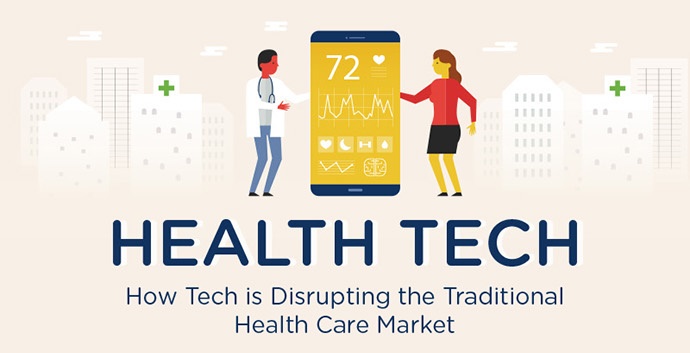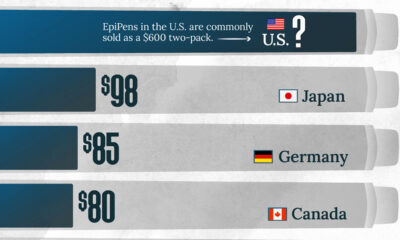Technology
Here’s How Tech is Disrupting the Traditional Healthcare Market
Tech is rapidly shaking up the traditional healthcare market in ways that could be described as both exciting and terrifying. Fortunately for investors, these disruptions are also creating new opportunities to solve some of the biggest health-related challenges facing the world today.
The following infographic from MW Homecare shows how healthcare is being impacted by emerging technologies and startup companies.

Healthcare: the big picture
Today’s healthcare industry faces many hurdles that are driving up costs. Political and economic uncertainty, an aging population, and a growing prevalence of chronic diseases are all contributing factors in the global push to find more cost-effective healthcare solutions.
The entire healthcare industry, from insurance providers to drug manufacturers, is seeking opportunities to reduce costs through modern technologies. This is playing into a wider trend towards a more personalized and efficient approach to healthcare. For investors, some of the most interesting crossroads between technology and healthcare may be found in big data, cybersecurity, developing markets, and strategic partnerships.
Big data
The collection and storage of large amounts of medical data, made possible by recent technological advancements, is helping healthcare professionals improve the quality of medical care, from research to diagnosis and treatment.
Investor interest in digital health startups that use big data to improve the efficiency and effectiveness of healthcare is increasing. These companies attracted $5.8 billion in funding in 2015, according to CB Insights – an increase of 20% over the previous year.
Cybersecurity
While technology is disrupting the healthcare industry in many positive ways, it’s also creating new challenges that will need to be addressed with greater urgency moving forward. One issue is the world’s growing reliance on cloud-based technology, which can place personal medical data at risk of security breaches.
Cyberattacks and IP theft are a growing threat to healthcare companies. According to Deloitte’s 2016 Global Life Sciences Outlook, in 2011 the U.K. government claimed that its life sciences and healthcare industry suffered $2.9 billion in losses due to IP theft.
Investment into cybersecurity technology has grown by 235% over the last five years, reaching a total of $3.9 billion in 2015 alone, according to CB Insights.
Developing markets
Currently, each country has its own complex regulatory and compliance systems which act as gatekeepers in the development of medical products. While these systems are necessary in order to ensure the safety and credibility of products before they go to market, they often clash with technology’s rapid pace of innovation.
Although the U.S. has been a leader in health tech innovation, current regulatory and compliance models tend to hold back progression. Digital health companies face heavy regulations in the U.S., which is causing investors to seek out new opportunities in developing markets such as China and India – two nations facing extreme healthcare costs against a backdrop of large aging populations and a rapid increase in chronic diseases such as cancer and diabetes.
China, with more than 185 million residents currently over the age of 60, is set to become the world’s most aged society by 2030. The Chinese government has responded to this looming economic threat by opening up opportunities for private foreign investment into its healthcare sector. As part of China’s recently implemented 13th Five-Year Plan, foreign senior care operators are now permitted to set up wholly–foreign owned enterprises (WFOE) in China, and are eligible to receive tax incentives, administrative fee exemptions and deductions and waivers. Chinese health companies are also seeking opportunities in foreign health technologies that will help China meet its domestic healthcare needs.
Strategic Partnerships
A trend that has been occurring with more frequency in recent years is the establishment of partnerships between tech giants and healthcare startups. For example, by partnering with Epic Systems in 2014, Apple’s Healthkit platform was able to integrate substantial amounts of patient data to leverage its digital health and tracking technologies.
Mergers and acquisitions within the digital health tech space have also been steadily growing over the last few years. In fact 2016 has been a record-breaking year for digital health tech M&A, with 41 deals in total – a solid increase over 2015’s total of 36 deals and 2014’s total of 33 deals. Many of these mergers and acquisitions are strategic moves by healthcare retail companies looking to build up their marketing presence and customer interaction platforms.
As technology continues to act as a catalyst for rapidly changing market dynamics within the healthcare industry, it is likely that strategic partnerships, co-investments, and M&A will continue to be key drivers of growth.
Technology
Ranked: Semiconductor Companies by Industry Revenue Share
Nvidia is coming for Intel’s crown. Samsung is losing ground. AI is transforming the space. We break down revenue for semiconductor companies.
Semiconductor Companies by Industry Revenue Share
This was originally posted on our Voronoi app. Download the app for free on Apple or Android and discover incredible data-driven charts from a variety of trusted sources.
Did you know that some computer chips are now retailing for the price of a new BMW?
As computers invade nearly every sphere of life, so too have the chips that power them, raising the revenues of the businesses dedicated to designing them.
But how did various chipmakers measure against each other last year?
We rank the biggest semiconductor companies by their percentage share of the industry’s revenues in 2023, using data from Omdia research.
Which Chip Company Made the Most Money in 2023?
Market leader and industry-defining veteran Intel still holds the crown for the most revenue in the sector, crossing $50 billion in 2023, or 10% of the broader industry’s topline.
All is not well at Intel, however, with the company’s stock price down over 20% year-to-date after it revealed billion-dollar losses in its foundry business.
| Rank | Company | 2023 Revenue | % of Industry Revenue |
|---|---|---|---|
| 1 | Intel | $51B | 9.4% |
| 2 | NVIDIA | $49B | 9.0% |
| 3 | Samsung Electronics | $44B | 8.1% |
| 4 | Qualcomm | $31B | 5.7% |
| 5 | Broadcom | $28B | 5.2% |
| 6 | SK Hynix | $24B | 4.4% |
| 7 | AMD | $22B | 4.1% |
| 8 | Apple | $19B | 3.4% |
| 9 | Infineon Tech | $17B | 3.2% |
| 10 | STMicroelectronics | $17B | 3.2% |
| 11 | Texas Instruments | $17B | 3.1% |
| 12 | Micron Technology | $16B | 2.9% |
| 13 | MediaTek | $14B | 2.6% |
| 14 | NXP | $13B | 2.4% |
| 15 | Analog Devices | $12B | 2.2% |
| 16 | Renesas Electronics Corporation | $11B | 1.9% |
| 17 | Sony Semiconductor Solutions Corporation | $10B | 1.9% |
| 18 | Microchip Technology | $8B | 1.5% |
| 19 | Onsemi | $8B | 1.4% |
| 20 | KIOXIA Corporation | $7B | 1.3% |
| N/A | Others | $126B | 23.2% |
| N/A | Total | $545B | 100% |
Note: Figures are rounded. Totals and percentages may not sum to 100.
Meanwhile, Nvidia is very close to overtaking Intel, after declaring $49 billion of topline revenue for 2023. This is more than double its 2022 revenue ($21 billion), increasing its share of industry revenues to 9%.
Nvidia’s meteoric rise has gotten a huge thumbs-up from investors. It became a trillion dollar stock last year, and broke the single-day gain record for market capitalization this year.
Other chipmakers haven’t been as successful. Out of the top 20 semiconductor companies by revenue, 12 did not match their 2022 revenues, including big names like Intel, Samsung, and AMD.
The Many Different Types of Chipmakers
All of these companies may belong to the same industry, but they don’t focus on the same niche.
According to Investopedia, there are four major types of chips, depending on their functionality: microprocessors, memory chips, standard chips, and complex systems on a chip.
Nvidia’s core business was once GPUs for computers (graphics processing units), but in recent years this has drastically shifted towards microprocessors for analytics and AI.
These specialized chips seem to be where the majority of growth is occurring within the sector. For example, companies that are largely in the memory segment—Samsung, SK Hynix, and Micron Technology—saw peak revenues in the mid-2010s.
-

 Mining2 weeks ago
Mining2 weeks agoCharted: The Value Gap Between the Gold Price and Gold Miners
-

 Real Estate1 week ago
Real Estate1 week agoRanked: The Most Valuable Housing Markets in America
-

 Business1 week ago
Business1 week agoCharted: Big Four Market Share by S&P 500 Audits
-

 AI1 week ago
AI1 week agoThe Stock Performance of U.S. Chipmakers So Far in 2024
-

 Misc1 week ago
Misc1 week agoAlmost Every EV Stock is Down After Q1 2024
-

 Money2 weeks ago
Money2 weeks agoWhere Does One U.S. Tax Dollar Go?
-

 Green2 weeks ago
Green2 weeks agoRanked: Top Countries by Total Forest Loss Since 2001
-

 Real Estate2 weeks ago
Real Estate2 weeks agoVisualizing America’s Shortage of Affordable Homes












